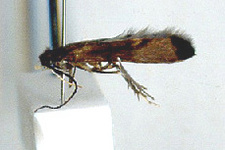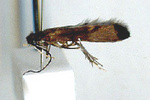Xiphocentronidae
Karl Kjer


This tree diagram shows the relationships between several groups of organisms.
The root of the current tree connects the organisms featured in this tree to their containing group and the rest of the Tree of Life. The basal branching point in the tree represents the ancestor of the other groups in the tree. This ancestor diversified over time into several descendent subgroups, which are represented as internal nodes and terminal taxa to the right.

You can click on the root to travel down the Tree of Life all the way to the root of all Life, and you can click on the names of descendent subgroups to travel up the Tree of Life all the way to individual species.
For more information on ToL tree formatting, please see Interpreting the Tree or Classification. To learn more about phylogenetic trees, please visit our Phylogenetic Biology pages.
close boxIntroduction
The family Xiphocentronidae was established by Ross (1949) for what he considered a very unusual small black caddisfly from Mexico. The family initially included only 3 species, the type species, Xiphocentron bilimeki Brauer, and 2 new species described by Ross, 1 from Mexico and the other from China, the latter now placed in Melanotrichia. As currently defined, Xiphocentronidae is a small family of 7 genera, including Abaria Mosely (ca. 20 species from the Oriental and Afrotropical regions), Cnodocentron Schmid (12 species from the southwestern USA to northern South America, as well as India and Southeast Asia), Drepanocentron Schmid (ca. 30 species from India, Malaysia, and the Philippines), Machairocentron Schmid (5 species from Central America and northern South America), Melanotrichia Ulmer (ca. 30 species from the eastern Palaearctic and Oriental regions), Proxiphocentron Schmid (3 species from India and Southeast Asia), and Xiphocentron Brauer (ca. 45 species widespread in the Neotropical region, extending into Mexico, the southwestern USA, and the Greater Antilles). (From Holzenthal et al. 2007).Characteristics
Larvae apparently graze diatoms and algae from rocks and typically inhabit elongate silken tubes covered with fine sand grains, either below the water line or extending onto the splash zone above the water surface, much like those of psychomyiids. However, Muñoz-Quesada and Holzenthal (1997) described the larva of a species of Xiphocentron from Costa Rica with the unusual habit of constructing a portable tube, short and arched, with openings at the anterior and posterior ends, giving the structure a shape something like that of a classic telephone handle. (From Holzenthal et al. 2007).Discussion of Phylogenetic Relationships
Schmid (1982) revealed the considerable diversity and widespread distribution of the family in a monograph devoted to it. The family status of Xiphocentronidae has generally been recognized since then. Schmid transferred several genera to the family and established the current taxonomic infrastructure, including the establishment of 4 new genera. His work included some 93 species, 73 newly described, or over half the total of about 140 now known for the family. When the larva of Xiphocentron was described by Edwards (1961), he recognized its close similarity to larvae of Psychomyiidae (as currently defined) and proposed that Xiphocentronidae should probably be synonymized with it. Larvae of both families have a similar overall appearance, with stout body and short legs, and a modified prothoracic trochantin, although that of Xiphocentronidae is less hatchet-shaped and partly membranous basally. (From Holzenthal et al. 2007).
In an analysis of 70 morpholigical characters, Frania and Wiggins (1997) found Xiphocentronidae to be sister to the Psychomyiidae. Kjer et al. (2001) confirmed this in their combined analyses, as well as four independent partitions. The combined analysis of Holenthal et al. (2007b) also showed this relationship.
References
Edwards, S.W. (1961) The immature stages of Xiphocentron mexico (Trichoptera). Texas Journal of Science, 13, 51–56.
Frania, H.E. & Wiggins, G.B. (1997) Analysis of morphological and behavioural evidence for the phylogeny and higher classification of Trichoptera (Insecta). Life Sciences Contributions, Royal Ontario Museum, 160, 1–67.
Holzenthal R.W., Blahnik, R.J., Prather, A.L., and Kjer K.M. 2007a. Order Trichoptera Kirby 1813 (Insecta), Caddisflies. In: Zhang, Z.-Q., and Shear, W.A. (Eds). 2007 Linneaus Tercentenary: Progress in Invertebrate Taxonomy. Zootaxa. 58 pp. 1668:639-698
Holzenthal R.W., Blahnik, R.J., Kjer K.M and Prather, A.L. 2007b. An update on the phylogeny of Caddisflies (Trichoptera). Proceedings of the XIIth International Symposium on Trichoptera. Bueno-Soria, R. Barba-Alvearz and B. Armitage (Eds). pp. 143-153. The Caddis Press.
Kjer, K.M., Blahnik, R.J. & Holzenthal, R.W. (2001) Phylogeny of Trichoptera (caddisflies): characterization of signal and noise within multiple datasets. Systematic Biology, 50, 781–816.
Muñoz-Quesada, F. & Holzenthal, R.W. (1997) A new species of Xiphocentron (Antillotrichia) from Costa Rica with semiterrestrial immature stges (Trichoptera: Xiphocentronidae). In: Holzenthal, R.W. & Flint, O.S., Jr. (Eds.) Proceedings of the 8th International Symposium on Trichoptera. Ohio Biological Survey, Columbus, Ohio, pp. 355–363.
Ross, H.H. (1949) Xiphocentronidae, a new family of Trichoptera. Entomological News, 60, 1–7.
Title Illustrations

| Scientific Name | Xiphocentron mnesteus |
|---|---|
| Location | Lara, Venezuela |
| Creator | Karl Kjer |
| Specimen Condition | Dead Specimen |
| Identified By | Ralph W. Holzenthal |
| Life Cycle Stage | Adult |
| View | Lateral |
| Collection | Univeristy of Minnesota UMSP |
| Collector | Holzenthal, Blahnik, Papr. & Cres. |
| Source Collection | Barcode of Life Database (BOLD) |
About This Page
Karl Kjer

Rutgers University, New Brunswick, New Jersey, USA
Correspondence regarding this page should be directed to Karl Kjer at
Page copyright © 2010 Karl Kjer
 Page: Tree of Life
Xiphocentronidae.
Authored by
Karl Kjer.
The TEXT of this page is licensed under the
Creative Commons Attribution-NonCommercial License - Version 3.0. Note that images and other media
featured on this page are each governed by their own license, and they may or may not be available
for reuse. Click on an image or a media link to access the media data window, which provides the
relevant licensing information. For the general terms and conditions of ToL material reuse and
redistribution, please see the Tree of Life Copyright
Policies.
Page: Tree of Life
Xiphocentronidae.
Authored by
Karl Kjer.
The TEXT of this page is licensed under the
Creative Commons Attribution-NonCommercial License - Version 3.0. Note that images and other media
featured on this page are each governed by their own license, and they may or may not be available
for reuse. Click on an image or a media link to access the media data window, which provides the
relevant licensing information. For the general terms and conditions of ToL material reuse and
redistribution, please see the Tree of Life Copyright
Policies.
- First online 20 July 2010
- Content changed 20 July 2010
Citing this page:
Kjer, Karl. 2010. Xiphocentronidae. Version 20 July 2010 (under construction). http://tolweb.org/Xiphocentronidae/14558/2010.07.20 in The Tree of Life Web Project, http://tolweb.org/







 Go to quick links
Go to quick search
Go to navigation for this section of the ToL site
Go to detailed links for the ToL site
Go to quick links
Go to quick search
Go to navigation for this section of the ToL site
Go to detailed links for the ToL site